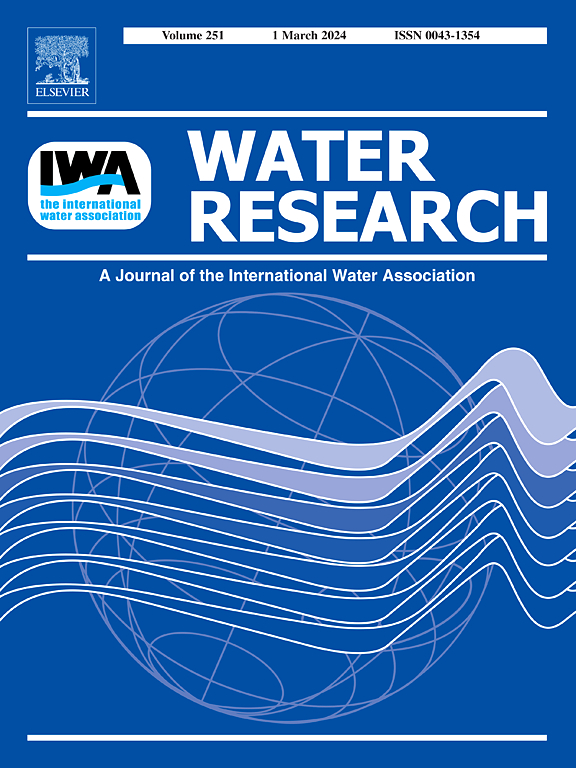Extreme precipitation amplified the cumulative effects of DOM availability on organic-sourced DIC in the Yangtze River
IF 12.4
1区 环境科学与生态学
Q1 ENGINEERING, ENVIRONMENTAL
引用次数: 0
Abstract
Frequent extreme climate events are restructuring riverine carbon cycles dominated by dissolved inorganic carbon (DIC). However, the variability of dissolved organic matter (DOM) induced by rainstorm and its linkage to riverine DIC dynamics remain unclear, limiting an in-depth understanding of carbon transport and fate across the river-ocean continuum. This study employed Fourier transform ion cyclotron resonance mass spectrometry (FT-ICR MS) coupled with stable carbon and water isotope tracing techniques to investigate DOM-DIC interactions in the Yangtze River. Results demonstrated that organic matter constituted a major DIC source, contributing 13.52 ± 1.66% and 23.15 ± 3.27% of total DIC during normal (May) and rainstorm (September) periods in 2021, respectively. Extreme precipitation events (>150 mm·day-1) elevated dissolved organic carbon (DOC) concentration and the biological transformation index (Ibio) of DOM, while reducing molecular mass and double-bond equivalents (DBE) compared to the normal condition. During the rainstorm period, DOC concentration and Ibio values progressively declined downstream with increasing distance from the precipitation core, while molecular mass and DBE increased, contrasting with the spatially homogeneous DOM distribution characteristic of the normal period. Rainstorm enhanced terrestrial organic matter inputs, increasing DOC concentration and enriching low-molecular-weight, highly saturated CHO and CHON compounds. These synergistic effects accelerated DOM biodegradation to organic-sourced DIC (DICoc). Structural equation modeling further confirmed that extreme precipitation primarily promoted DICoc production through stimulated DOM biodegradation rather than photochemical oxidation. Storm events mobilized protein-like compounds from residential wastewater, while elevated water temperatures and nutrient levels collectively enhanced DOM biodegradability. Conversely, rainstorm-induced turbidity plumes suppressed photodegradation of terrestrial aromatic humic substances. Our findings highlight that precipitation-driven DOM loading and molecular transformations significantly accelerate biogeochemical carbon cycling.


极端降水放大了DOM有效性对长江有机源DIC的累积效应
频繁的极端气候事件正在重构以溶解无机碳(DIC)为主的河流碳循环。然而,暴雨引起的溶解有机质(DOM)变异性及其与河流DIC动力学的联系尚不清楚,限制了对河海连续体中碳运输和命运的深入了解。本研究采用傅里叶变换离子回旋共振质谱(FT-ICR MS)结合稳定碳和水同位素示踪技术研究了长江中DOM-DIC的相互作用。结果表明,有机质是主要的DIC来源,在2021年正常期(5月)和暴雨期(9月)有机质分别占总DIC的13.52±1.66%和23.15±3.27%。极端降水事件(>150 mm·day-1)提高了溶解有机碳(DOC)浓度和DOM的生物转化指数(Ibio),同时降低了分子质量和双键当量(DBE)。暴雨期DOC浓度和Ibio值随离降水核心距离的增加而向下游逐渐下降,而分子质量和DBE则增加,与正常期DOM空间均匀分布的特征形成鲜明对比。暴雨增加了陆相有机质输入,增加了DOC浓度,丰富了低分子量、高饱和的CHO和CHON化合物。这些协同作用加速了DOM生物降解为有机源DIC (DICoc)。结构方程模型进一步证实,极端降水主要通过刺激DOM生物降解而非光化学氧化促进DICoc生成。风暴事件动员了生活废水中的蛋白质样化合物,而水温和营养水平的升高共同增强了DOM的生物降解性。相反,暴雨引起的浊度羽状物抑制了陆生芳香腐殖质的光降解。研究结果表明,降水驱动的DOM加载和分子转化显著加速了生物地球化学碳循环。
本文章由计算机程序翻译,如有差异,请以英文原文为准。
求助全文
约1分钟内获得全文
求助全文
来源期刊

Water Research
环境科学-工程:环境
CiteScore
20.80
自引率
9.40%
发文量
1307
审稿时长
38 days
期刊介绍:
Water Research, along with its open access companion journal Water Research X, serves as a platform for publishing original research papers covering various aspects of the science and technology related to the anthropogenic water cycle, water quality, and its management worldwide. The audience targeted by the journal comprises biologists, chemical engineers, chemists, civil engineers, environmental engineers, limnologists, and microbiologists. The scope of the journal include:
•Treatment processes for water and wastewaters (municipal, agricultural, industrial, and on-site treatment), including resource recovery and residuals management;
•Urban hydrology including sewer systems, stormwater management, and green infrastructure;
•Drinking water treatment and distribution;
•Potable and non-potable water reuse;
•Sanitation, public health, and risk assessment;
•Anaerobic digestion, solid and hazardous waste management, including source characterization and the effects and control of leachates and gaseous emissions;
•Contaminants (chemical, microbial, anthropogenic particles such as nanoparticles or microplastics) and related water quality sensing, monitoring, fate, and assessment;
•Anthropogenic impacts on inland, tidal, coastal and urban waters, focusing on surface and ground waters, and point and non-point sources of pollution;
•Environmental restoration, linked to surface water, groundwater and groundwater remediation;
•Analysis of the interfaces between sediments and water, and between water and atmosphere, focusing specifically on anthropogenic impacts;
•Mathematical modelling, systems analysis, machine learning, and beneficial use of big data related to the anthropogenic water cycle;
•Socio-economic, policy, and regulations studies.
 求助内容:
求助内容: 应助结果提醒方式:
应助结果提醒方式:


